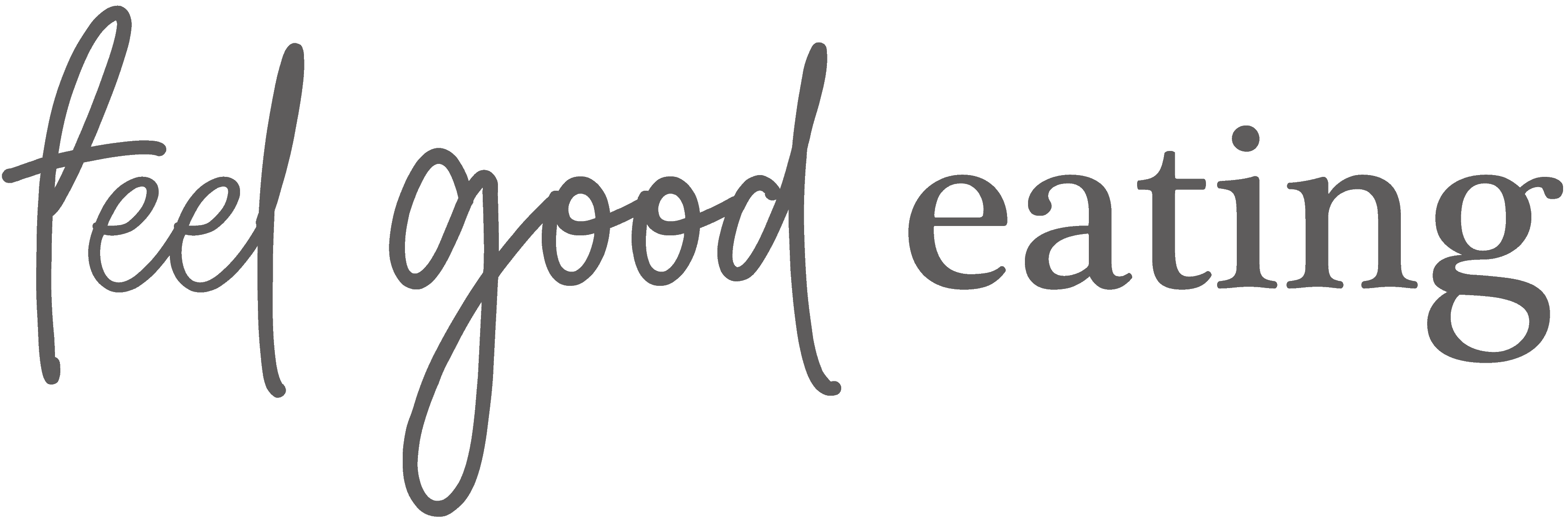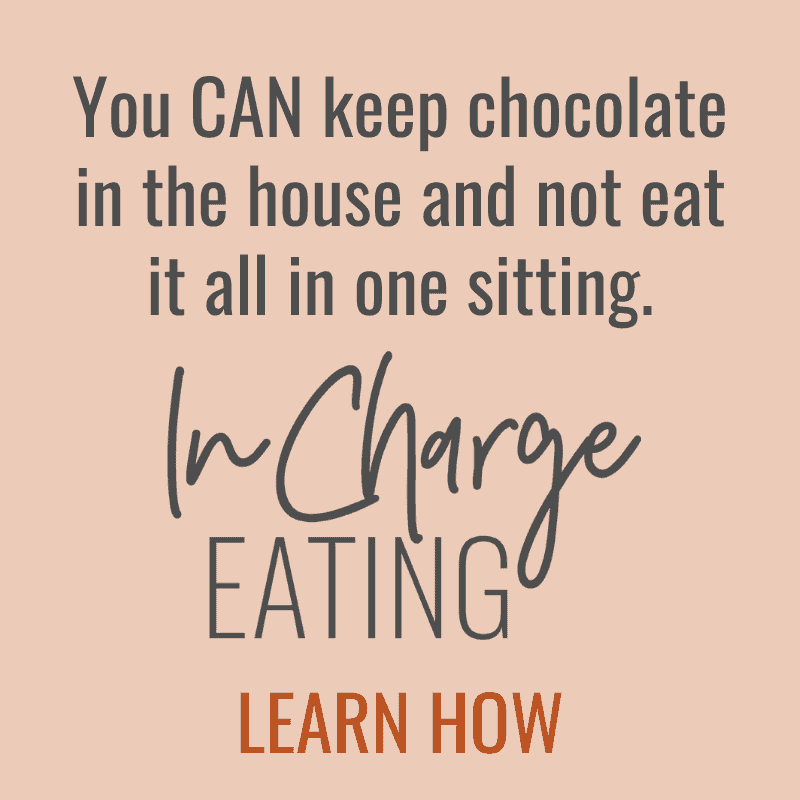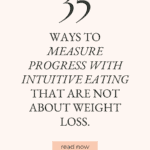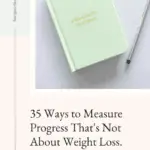When we’re pursuing weight loss, the goal is pretty simple.
Lose weight.
Which kinda makes ‘measuring progress’ simple as well.
Because weight loss is tangible, we know when it’s ‘working’.
We know it’s working when the number on the scale is decreasing.
We know we’re on the right track when we need to buy new (smaller) clothes.
So, what do we do when it comes to Intuitive Eating where weight loss isn’t the outcome of focus?
Well first…
Wanting to Measure Progress is Natural
When you’ve invested so much time, energy, emotion and money into Diet Culture and it hasn’t ‘paid off’, it’s understandable that taking an anti-diet approach to your eating, your body image and your relationship with food feels risky.
You want to know that you’re on the right track to build confidence that this isn’t going to be another thing that fails.
Especially if other people are questioning what you are doing or aren’t open to understanding (read: pretty much everyone else who is still wrapped up in Diet Culture).
And, if you’re like many of my clients, ‘knowing it’s working’ in the beginning is still often tied up with weight. Intuitive Eating is seen to be ‘working’ if their weight doesn’t increase and it’s working even better if they are losing weight. I wonder if that feels similar for you?

What Makes Measuring Progress With Intuitive Eating Tricky
Straight up is the fact that the purpose of Intuitive Eating isn’t weight loss.
This can make thinking about what ‘progress’ might be instead very uncomfortable and disconcerting.
What are we doing if we’re not working towards a smaller body? It flies in the face of everything Diet Culture has taught us.
The second thing that makes ‘measuring progress’ tricky stems from the fact that practising Intuitive Eating isn’t as tangible as dieting. It’s harder to grasp what you’re actually doing sometimes when a lot of the work is internal.
The Difference Between Measuring Progress With Dieting Compared to Intuitive Eating
Thinking about how to measure progress without focusing on weight loss reminded me of two methods for conducting research and using the data- known as quantitative and qualitative.
Quantitative
Quantitative data deals with numbers, counting, and statistics. Results are gathered by measuring and counting things and are quite factual- there’s no grey area here.
Weight loss or traditional diet culture ways of thinking about food, eating, movement, and health focus heavily on quantitative markers of improvement.
For example:
- I’ve lost Xkg.
- I’m only eating X food X times a week.
- I work out X times a week.
- I fit into size X jeans now.
- My waist circumference has reduced by Xcm.
We’re familiar with this way of thinking. It’s our default.
Qualitative
Qualitative data is descriptive and uses words and language rather than numbers. And it is often collected by observing and noticing patterns, rather than measuring.
Non-diet approaches embrace qualitative data. Asking how things FEEL and inviting you to explore change and progress with narrative rather than numbers. There’s more of a focus on getting curious about the WHY and the HOW rather than just the black-and-white WHAT.
For example:
- I feel less obsessed about food.
- My binges feel less intense and are fewer and far between now.
- I feel like my energy levels are more stable and consistent throughout the day.
- I work out when my body tells me it wants to move. And that’s pretty regularly now.
- I’m more interested in expressing my style and personality through fashion than it only being about wearing a smaller size.
That’s not to say that quantitative improvements can’t be used as an indicator of progress.
We know that with Intuitive Eating, biomarker improvements (like cholesterol and blood pressure) can offer numerical indicators of ‘progress’.
And when the time is right, we can explore gentle nutrition and improvements to diet quality with quantitative data, e.g. “I’ve gone from having no vegetables on my plate to having 2 most nights at dinner.”
35 Ways to Measure Progress That’s Not About Weight Loss.
Here are some non-scale, non-diety ideas for how to measure progress with your relationship with food and body that you can take and run with, or use as a jumping-off point for coming up with your own. Note: these may or may not be relevant based on what is important to you – these are definitely not a checklist of things you need to tick off to say you have ‘achieved’ Intuitive Eating!
- You have more energy or sustained energy across the day.
- You’re thinking less about food and the obsession around food has reduced.
- You’re nourishing your body regularly and that regularity is consistent across the week, month etc.
- You feel comfortable eating snacks.
- There’s a reduction in the intensity and/or frequency of binges, ‘overeating’ or feeling out of control around food.
- Your mood feels more even/stable.
- You feel better equipped to move through big or uncomfortable emotions or situations that would previously have you instantly turning to food.
- The variety of food you eat has increased.
- You’re more connected with people at meal times rather than staying up in your head.
- You’re more connected with your body at meal times rather than remaining up in your head.
- Your language around food is different – you’re not referring to food as good/bad, junk, healthy/unhealthy as often.
- Things feel more flexible – your thinking, your choices and you can be spontaneous with eating.
- You’re better connected with how different foods feel in your body.
- You’re spending less money on takeaway and UberEats (this is a big one for many of my clients that combines their relationship with food and relationship with money goals)
- Your food choices are made based on what you feel like, how hungry you are, and what’s going to taste good rather than your food rules.

- You feel solid in your food choices and don’t second guess them.
- You actually enjoy eating again! There’s less anxiety around food and eating doesn’t feel like a chaotic and stressful event.
- You can climb stairs or hike up a hill without feeling as out of breath.
- You’re experiencing fewer digestive issues.
- You feel less panicked about what might happen with your weight.
- You wake up feeling refreshed and ready to start your day.
- You don’t feel guilty as often after eating.
- You don’t feel guilty for taking a rest day from working out.
- You can lift heavier weights, do more reps, carry the shopping up stairs, run around after your kids easier etc.
- You are picking up on earlier signals of hunger.
- You feel more confident feeling and responding to your fullness cues.
- You’re no longer a member of the Clean Plate Club and feel comfortable leaving food behind.
- Eating is happening with more intentionality and presence.
- You don’t beat yourself up and are more compassionate if you eat past fullness, binge, eat a meal that was unsatisfying, or eat to soothe your emotions.
- You’re weighing yourself less frequently, or you’ve ditched the scale altogether and that doesn’t freak you out.
- You move your body because you enjoy it, rather than as a punishment.
- You’re seeing improvements in your blood pressure, blood glucose, cholesterol, liver function etc.
- You acknowledge the systems in place that oppress bodies, rather than blaming your body for being ‘a problem’.
- You can see how internalised weight bias is harming you and keeping you stuck and are willing to work on challenging it.
- You no longer say; “I don’t have a problem with anyone else being fat, but it’s not OK for me.” and believe your worth is greater than what you weigh.
Moving Away From ‘Measuring’ Progress.
One final thing I’d invite you to consider is:
Does wanting something to measure help? Or is it putting an obstacle in your path? (FYI there’s no right or wrong answer here- you get to choose!).
I know it’s hard to let go of the need to know it’s ‘working’ when we’re used to operating in a system that only views things as either ‘working’ or ‘not working’.
The frustrating beauty of non-diet approaches like Intuitive Eating is that even the stuff that feels like ‘not working’ can provide insight and learning.
For example, ‘overeating’ at dinner can make you feel like ‘this isn’t working’. But it may actually be an insight that you didn’t get enough to eat earlier in the day. The ‘not working’ suddenly is a place for learning and growing.
And, I’ll admit I can be a bit pedantic about language in this work because our words matter.
In this case, ‘measuring’ still implies a quantifiable change which is what weight loss dieting is famous for. So, if you hold fast to wanting something to measure as a sign of progress, you may run the risk of activating your diet mentality (And just end up swapping measuring your portions, calories, and steps for something new).
Rather than asking; “How do I measure my progress so I know this is working?” you could ask;
What might I be noticing about…(my eating/mood/energy/binges/body image/nervous system etc.) that will tell me…(I’m headed in the direction I want to be going/my relationship with food and body is shifting/I’m recovering/I’m less wrapped up in Diet Culture/I’m more connected with my body etc.).
Or;
“If I take weight out of the equation for a minute, what would I love to be different about my relationship with food and body in 3 months, 6 months, a year?”
Those two questions may just give you a deeper, richer and more fulfilling path forward.
Wrapping Up
So, if you’re struggling to know if all the work you’re doing to move away from diets and have a better relationship with food is ‘working’, I hope these non-numerical benchmarks offer something for you to anchor to so you can keep going.
It will be worth it!

 Hi! My name is Nina.
I’m a Certified Intuitive Eating Counsellor taking the ‘diet’ out of Dietitian. I am here to help you reject diet culture, tune into your body’s own inner wisdom about how to truly nourish yourself and ultimately feel good eating™
Hi! My name is Nina.
I’m a Certified Intuitive Eating Counsellor taking the ‘diet’ out of Dietitian. I am here to help you reject diet culture, tune into your body’s own inner wisdom about how to truly nourish yourself and ultimately feel good eating™ 

